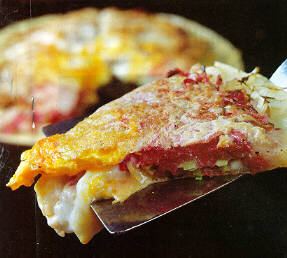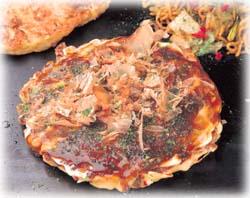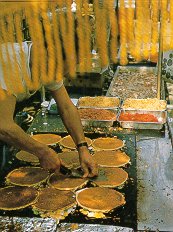
Okonomi-yaki

The term okonomi-yaki means "cook-as-you-please." It is an egg-based, doughy pancake filled with cabbage, shrimp and other items.
It is a descendant of ishi-yaki (stone cooking) where flower and water was griddled on the surface of a hot, flat stone. In the mid-16th century Sen no Rikyuu (the practioner of the Tea Ceremony), used a form of ishi-yaki to make his tea cakes. He used a frying pan instead of a stone and smeared the pancakes with sweetened miso (a soy bean paste) and rolled them up, making what is known as fu-no-yaki.
The material then underwent further evolution. About 150 years ago monja-yaki came into being. It was made from a thin batter friend on a hot plate and eaten with toy-sized metal spatulas. It was a sticky treat very popular with children.
Later it evolved into dondon-yaki which consisted of batter, tiny dried shrimp, bits of fried tempura butter and a spicy sauce. It was inexpensive and popular in the late 19th and early 20th centuries.
The modern form of okonomi-yaki appeared about 45 years ago.
The making and eating of okonomi-yaki can be a communal experience. Customers sit around a table which has hot-plates on it. The customers then make their own pancakes, adding the materials they wish. The modern okonomi-yaki is sprinkled with dried seaweed and fish flakes, then brushed with a rich brown sauce and sometimes topped with mayonnaise.
Okonomi-yaki can also vary by the city it is fixed in. In Osake the okonomi-yaki is prepared by lightly frying the cabbage-topped batter then adding toppings to taste like shellfish, meant and eggs.
In Hiroshia the okonomi-yaki consists of one or two layers of bean sprouts, cabbage, meat and other added materials between layers of lightly fried batter. Finally a thick spread of sauce finishes off the pancake.
In Tokyo people mix the batter with the filling before putting it on the hot plate. They prefer thinner hotcakes and use less sauce.


|